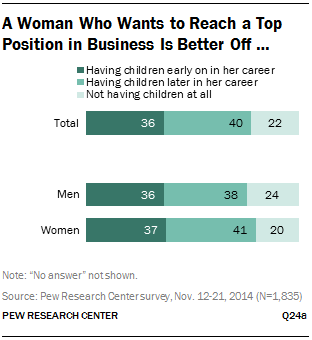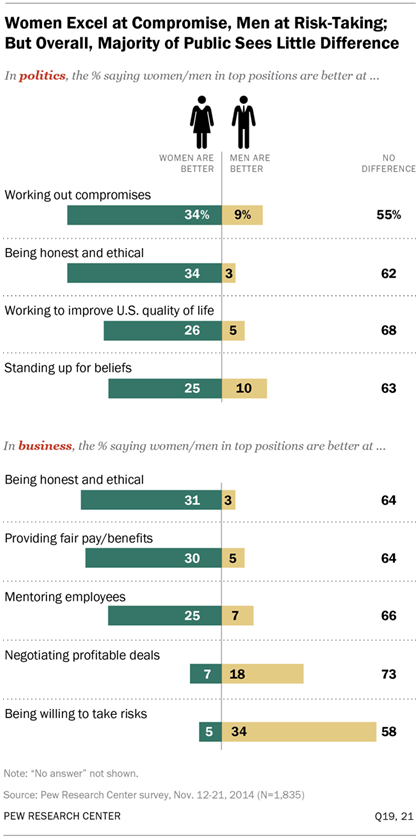
According to the majority of Americans, women are every bit as capable of being good political leaders as men. The same can be said of their ability to dominate the corporate boardroom. And according to a new Pew Research Center survey on women and leadership, most Americans find women indistinguishable from men on key leadership traits such as intelligence and capacity for innovation, with many saying they’re stronger than men in terms of being compassionate and organized leaders.
So why, then, are women in short supply at the top of government and business in the United States? According to the public, at least, it’s not that they lack toughness, management chops or proper skill sets.
It’s also not all about work-life balance. While economic research and previous survey findings have shown that career interruptions related to motherhood may make it harder for women to advance in their careers and compete for top executive jobs, relatively few adults in the new Pew Research survey point to this as a key barrier for women seeking leadership roles.1 Only about one-in-five say women’s family responsibilities are a major reason there aren’t more females in top leadership positions in business and politics.


As a result, the public is divided about whether, even in the face of the major advances women have made in the workplace, the imbalance in corporate America will change in the foreseeable future. About half (53%) believe men will continue to hold more top executive positions in business in the future; 44% say it is only a matter of time before as many women are in top executive positions as men. Americans are less doubtful when it comes to politics: 73% expect to see a female president in their lifetime.
These findings are based on a new Pew Research Center survey of 1,835 randomly selected adults conducted online Nov. 12-21, 2014. The survey also finds that the public is divided over whether a woman with leadership aspirations is better off having children early on in her career (36%) or waiting until she is well established (40%). About one-in-five (22%) say the best option would be to not have children at all.
Getting the Job Done in Politics and Business

When it comes to characteristics that apply specifically to political and business leadership, most Americans don’t distinguish between men and women. But among those who do draw distinctions, women are perceived to have a clear advantage over men in some key areas.
Just as in the political realm, the public does not see major differences between men and women on key business leadership qualities. Where they do see gaps, women have a clear advantage over men on honesty and ethics, providing fair pay and benefits, and offering mentorship to young employees. Men have an edge when it comes to being willing to take risks and negotiating profitable deals.
Women in Leadership Today

As the 114th Congress gets underway, a record number of women (104) will be serving in the House and Senate. Today women make up 19% of the Congress, about double the share from 20 years ago. Progress has been slower on the corporate front. Only 26 women are now serving as CEOs of Fortune 500 companies—roughly 5%. In 1995 there were none. Women are slightly better represented in corporate boardrooms than they are at the CEO level. As of 2013, about one-in-six board members of Fortune 500 companies (17%) were women, up from 10% in 1995.2
The pipeline for female leaders seems to be widening. Women have made significant gains in educational attainment in recent decades, better positioning themselves not only for career success but also for leadership positions. Since the 1990s, women have outnumbered men in both college enrollment and college completion rates, reversing a trend that lasted through the 1960s and ’70s. And women today are more likely than men to continue their education after college.
Women have also made inroads into managerial positions and professional fields in recent decades. In 2013, over half of managerial and professional occupations in the U.S. (52.2%) were held by women, up from 30.6% in 1968.3 Even so, women continue to lag far behind men in senior management positions.4
Gender and Party Gaps in Views on Female Leadership
For women, the issue of having more female leaders goes far beyond equality in the workplace. Four-in-ten of them (38%) say having more women in top leadership positions in business and government would do a lot to improve the quality of life for all women. An additional 40% of women say this would have at least some positive impact on all women’s lives. For their part, men are less convinced that female leadership has such wide-ranging benefits. Only 19% of men say having more women in top leadership positions would do a lot to improve all women’s lives, while 43% say this would improve women’s lives somewhat.

When it comes to the barriers that may be holding women back from achieving greater representation in the top leadership ranks, women are much more likely than men to point to societal and institutional factors such as the country not being ready to elect more female political leaders and women being held to higher standards than men in business and in government.
Women are also more likely than men to say that female leaders in both politics and business outperform male leaders on most of the traits and characteristics tested in the survey. The gender gaps in perceptions about political leadership are especially sharp. Whether on compromise, honesty, backbone, persuasion or working for the benefit of all Americans, women are more likely than men to say female leaders do a better job. For their part, solid majorities of men say there aren’t major differences between men and women men in these areas. Nonetheless, they are somewhat more likely than women to give a nod to male leaders over female leaders on four of the five political leadership qualities tested in the poll.
Those who identify with the Democratic Party, which dominates the ranks of elected female leaders at the federal and state levels today, also have more favorable impressions of the women who serve in leadership positions in government and in business.
When it comes to political leadership, Democrats are significantly more likely than Republicans to say that women do a better job than men on each of the attributes tested in the poll. For their part, Republicans are not necessarily more likely to favor men in these areas, but they are more inclined to say there isn’t any difference between men and women.
Democratic women in particular are strong proponents of female political leaders. In most cases, they are more likely than both Democratic men and Republican women to say that female political leaders do a better job men.

The remainder of this report examines the current landscape of women in leadership in the U.S. and the public’s views on this topic. Chapter 1 lays out trends in female leadership in elected political office and in corporate America, as well as changes in the pipelines to top leadership positions. Chapter 2 looks at public attitudes on men, women and key leadership traits in both the political and business realms. And Chapter 3 explores the obstacles to leadership for women, as well as views about discrimination and the future of female leadership.
Other Key Findings
Women and men are seen as equally good business leaders, but gender stereotypes persist. Most Americans (54%) say men would do a better job running a professional sports team, while just 8% say women would be better at this. And a 46% plurality also give men the edge when it comes to running a large oil or gas company. But the public is two and a half times more likely to say a woman, rather than a man, would do a better job running a major hospital or a major retail chain.
Young adults are more likely than older generations to say women with leadership aspirations might want to delay having children. More than four-in-ten Millennials (46%) say a woman who wants to reach a top position in business is better off waiting to have children until she is well established in her career, while 29% say she should have children early in her career. By contrast, four-in-ten Boomers and nearly half (48%) of members of the Silent generation say it’s better for a woman with high-level business aspirations to have children early on.
Among partisans, Republican men are the most likely to say the country has taken the steps needed to achieve gender equality in the workplace. About half of Republican men (54%) say the country has made the changes needed to give men and women equality in the workplace. By contrast about two-thirds (66%) of Republican women say more changes are needed. Even larger majorities of Democratic and independent women and Democratic men agree that gender parity is still a work in progress.
A Note on Generations
Some of the analysis in this report looks at adults by generation. While the definitions of generations can differ slightly among researchers, this report relies on the following standard Pew Research definitions.
- Millennials: born after 1980, ages 18 to 33 in 2014.5
- Generation X: born from 1965 to 1980, ages 34 to 49 in 2014.
- Baby Boomers: born from 1946 to 1964, ages 50 to 68 in 2014.
- The Silent Generation: born from 1928 to 1945, ages 69 to 86 in 2014.6
About This Report
This report explores public attitudes about gender and leadership with a particular focus on leadership in U.S. politics and business. The analysis is based on two new Pew Research Center surveys. The main survey was conducted Nov. 12-21, 2014, among a sample of 1,835 adults – 921 women and 914 men – 18 years of age or older. The survey was conducted by the GfK Group using KnowledgePanel, its nationally representative online research panel. A second survey was conducted Nov. 20-23, 2014, among 1,004 adults, 18 years of age or older, living in the continental United States. This survey was conducted over the telephone (landline and cellular phone) under the direction of Princeton Survey Research Associates International. For a more detailed description of the survey methodology, see Appendix A.
In addition to the surveys, this report draws on data from a variety of sources to document women in leadership positions in politics (national and state levels) and in business with trends over time.
This report is a collaborative effort based on the input and analysis of the following individuals. Claudia Deane, director of research practices, and Rich Morin, senior editor, provided editorial guidance. Kim Parker, director of social trends research, and Juliana Menasce Horowitz, associate director of research, designed the surveys and wrote the overview and two main survey chapters. Wendy Wang, senior researcher, and Anna Brown, research assistant, compiled the data for the chapter on female leadership. Wang wrote the chapter on female leadership. Brown and Eileen Patten, research analyst, number-checked the report. The report was copy-edited by Marcia Kramer of Kramer Editing Services. Michael Suh provided Web support. Find related reports online at www.pewresearch.org/pewresearch-org/social-trends.




